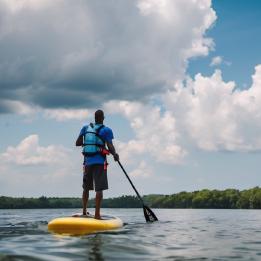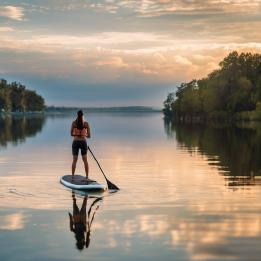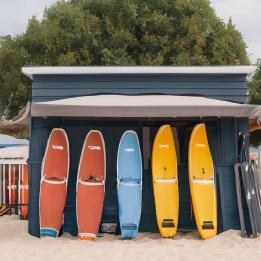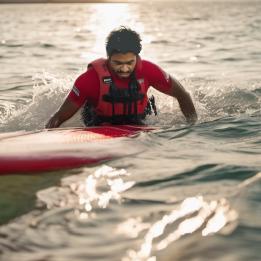Can You Sit on a Paddleboard? When Sitting is an Option

Paddleboards come in a few different shapes and sizes, all designed to be stable enough for standing up while paddling. But can you sit on a paddleboard if you prefer?
In this article, we’ll cover if and when sitting is an option when paddleboarding. We’ll also compare the pros and cons of sitting versus standing on a SUP.
Are Paddleboards Designed for Sitting?
Paddleboards are typically designed with standing in mind first and foremost. The wider, thicker boards create a stable platform for paddling while upright.
However, most standard SUPs do have enough deck space to support sitting, especially if you stay centered on the board. Wider “all-around” boards are best for accommodating a sitting paddler.
There are also inflatable boards made specifically for sitting, with raised and padded seat attachments. Sit-on-top kayaks blend design elements of kayaks and paddleboards to optimize for seated paddling.
Paddleboards aren’t just for standing - sitting can be a nice change of pace!
So while stand up paddleboarding is the norm, paddleboards can definitely be sat on as well. It comes down to comfort and intended use.
When Is Sitting Preferable to Standing on a Paddleboard?
For the typical SUP experience, standing up paddleboarding is recommended. But there are instances where taking a seat makes more sense:
Paddling With Dogs
Bringing along your furry friend? Sitting provides more room and stability for a dog passenger while also letting you interact. Use a boarding leash to keep your pup safe.
Relaxing Paddles
If you want a mellow, peaceful paddle rather than exercise, sitting allows you to cruise along and soak up the scenery.
SUP Yoga
In paddleboard yoga, sitting poses are easier to balance and transition to/from. Sitting also lets you take breaks between standing postures.
Racing & Endurance Paddling
The ability to sit and change up your stance helps when paddleboarding long distances by working different muscles.
Non-Standing Conditions
Choppy water, strong winds or lack of balancing ability can make sitting the safer, comfier choice. Use good judgement based on conditions.
Pros and Cons of Sitting vs. Standing on a Paddleboard
Deciding between sitting and standing depends on your specific paddleboarding goal. Here are some general pros and cons of each stance:
Sitting Pros:
- More stable paddling platform
- Ability to take breaks from standing
- Opens up more board space for cargo or passengers
- Low center of gravity lessens risk of falling
- Feet immersed in water helps with cooling
- Less physical effort required overall
Sitting Cons:
- Less engagement of core muscles and balance
- Reduced leg/glute workout
- Decreased vantage point to see surroundings
- Increased wetness since you sit lower
- Less ability to adjust weight for stability
Standing Pros:
- Full-body workout for arms, core, legs
- Improves balance and board control
- Higher viewpoint to see conditions
- Keeps lower body dryer
- Classic SUP paddling stance
Standing Cons:
- Harder on the ankles, knees and back without breaks
- Increased risk of falling until skill builds
- Constant engagement required for stability
- Less space for additional cargo or passengers
Finding Your Ideal Paddling Position
“Can you sit on a paddleboard” is question many beginners ask. But paddleboarding is fun no matter your stance, so don’t be afraid to switch it up! Take a few seated paddles if you need a break from standing or just want a relaxing cruise. Or stick to standing if you really want to work your balance and burn calories.
Try out different paddleboarding positions across various conditions to see what fits your personality and goals best. The right stance for you will enhance your enjoyment and time spent out on the water.
Have any other questions about sitting on a paddleboard versus standing up? Let me know!



